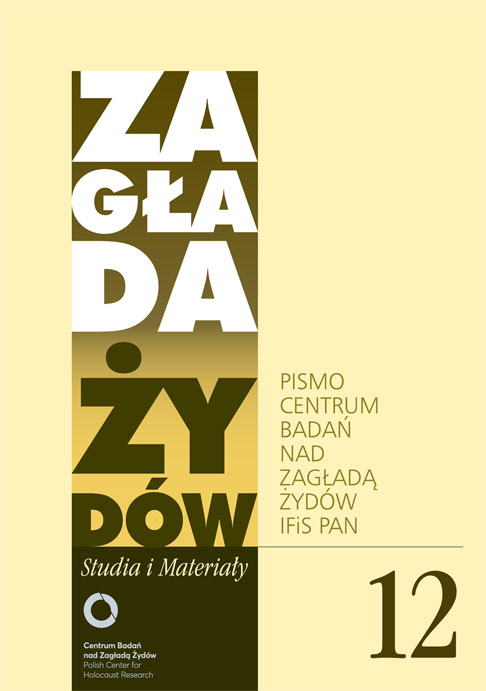Frankenstein w warszawskim getcie. Historia i legenda
Zagłada Żydów. Studia i Materiały, Nr 12 (2016), Strony: 187-208
Data zgłoszenia: 2020-10-19Data publikacji: 2016-11-30
 https://doi.org/10.32927/ZZSiM.414
https://doi.org/10.32927/ZZSiM.414
Abstrakt
The article deals with one exceptionally violent German perpetrator who was part of the occupation force in Warsaw during the Second World War. Inside the Ghetto he maltreated and killed a large number of women, children and men for his own personal pleasure. He did this to such an extensive degree that the population perceived him as monstrous being that was given the nickname „Frankenstein”. The article is mainly based on statements in juridical investigations, from the victim as well as from the perpetrator perspective, supplemented with some selected additional sources. Firstly the source corpus will be evaluated, to work out how these historical sources can be used to shed light on „Frankenstein”. This will be followed by an analysis of the actual identity of this perpetrator. It will be shown that he was, contrary to common belief, not necessarily the SS-Rottenführer Josef Blösche but more likely a member of the German Police Battalion 61. In the end the question will be also raised of how it was possible – despite all rules and regulations – that ghetto guards like him behaved like a marauding soldiery.
Słowa kluczowe
getto warszawskie , Zagłada , policja umundurowana , zbrodnie okupacyjne , warty w getcie , batalion policyjny , sprawca , przemoc , strach , terror , życie w getcie
Licencja
Prawa autorskie (c) 2016 Autor & "Zagłada Żydów. Studia i Materiały"

Utwór dostępny jest na licencji Creative Commons Uznanie autorstwa 4.0 Międzynarodowe.
https://creativecommons.org/licenses/by/4.0
Podobne artykuły
- Dariusz Libionka, Apokryfy z dziejów Żydowskiego Związku Wojskowego i ich autorzy. , Zagłada Żydów. Studia i Materiały: Nr 1 (2005)
- Aleksandra Bańkowska, Partyzantka polska lat 1942–1944 w relacjach żydowskich , Zagłada Żydów. Studia i Materiały: Nr 1 (2005)
- Andrzej Żbikowski, Teksty pogrzebane w niepamięci. Relacje dwóch uciekinierek z masowego grobu Poniatowa , Zagłada Żydów. Studia i Materiały: Nr 1 (2005)
- Jan Grabowski, Tadeusz Tomasz Krasnodębski, Policjant konspiratorem. Szesnaście lat na muszce Gestapo i bezpieki [Policeman-Conspirator. Sixteen years on a sight of Gestapo and State Security] , Zagłada Żydów. Studia i Materiały: 2010: Holocaust Studies and Materials
- Janusz Salamon, SJ, Christian-Jewish Dialogue in the Land of Sick Imagination. On the Margins of Waldemar Chrostowski’s Book Kościół, Żydzi, Polska , Zagłada Żydów. Studia i Materiały: 2010: Holocaust Studies and Materials
- Jan Grabowski, “I Wish to Add that I was not Aware and Carried out the Task as a Soldier of the Home Army”. On the Murder of Jews Hiding near Racławice by a Company of the Miechów Home Army , Zagłada Żydów. Studia i Materiały: 2010: Holocaust Studies and Materials
- Jacek Leociak, Censorship Keeping Guard over the Church. Krystyna Modrzewska’s Censored Memoir , Zagłada Żydów. Studia i Materiały: 2010: Holocaust Studies and Materials
- Jacek Leociak, “I don’t want people laughing at me for hiding Jews at my place . . .” The Case of Zdzisław and Halina Krzyczkowski , Zagłada Żydów. Studia i Materiały: 2010: Holocaust Studies and Materials
- Marcin Zaremba, CV pogromu , Zagłada Żydów. Studia i Materiały: Nr 14 (2018)
- Grzegorz Krzywiec, A Polish Weininger? The Case of Julian Unszlicht (1883–1953) , Zagłada Żydów. Studia i Materiały: 2010: Holocaust Studies and Materials
<< < 12 13 14 15 16 17 18 19 20 21 22 23 24 25 26 27 28 29 30 31 32 33 34 35 36 37 38 39 40 41 42 43 44 45 > >>
Możesz również Rozpocznij zaawansowane wyszukiwanie podobieństw dla tego artykułu.
 English
English
 Język Polski
Język Polski








